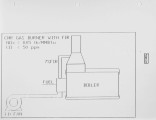| Title |
Retrofitting Ultra Low NOx Burners for Multiple Burner Boilers |
| Creator |
Beale, Frank |
| Publisher |
Digitized by J. Willard Marriott Library, University of Utah |
| Date |
1994 |
| Spatial Coverage |
presented at Maui, Hawaii |
| Abstract |
In order to meet the NOx guarantee of 0.10 Ibs/ MMBtu when firing refinery fuel gas and provide the very stringent flame pattern requirements over the entire load range, John link retrofitted three (3) boilers each with four (4) burners employing revolutionary "FIR" (fuel induced recirculation) technology licensed from Holman Boiler Works. This technology achieved an average missions of 0.07 Ibs/MM Btu for all three boilers firing refinery fuel gas with an average HHV of 1300 Btu/FT3 without the need for a forced FGR (Flue Gas Recirculation) fan and control loop. This installation provided the opportunity and led to the development of our newest John link member of the INFURNOx (™) family of burners, the CMR (Control Mix Recirculation) boiler burner. |
| Type |
Text |
| Format |
application/pdf |
| Language |
eng |
| Rights |
This material may be protected by copyright. Permission required for use in any form. For further information please contact the American Flame Research Committee. |
| Conversion Specifications |
Original scanned with Canon EOS-1Ds Mark II, 16.7 megapixel digital camera and saved as 400 ppi uncompressed TIFF, 16 bit depth. |
| Scanning Technician |
Cliodhna Davis |
| ARK |
ark:/87278/s6qz2djk |
| Setname |
uu_afrc |
| ID |
9367 |
| Reference URL |
https://collections.lib.utah.edu/ark:/87278/s6qz2djk |




























